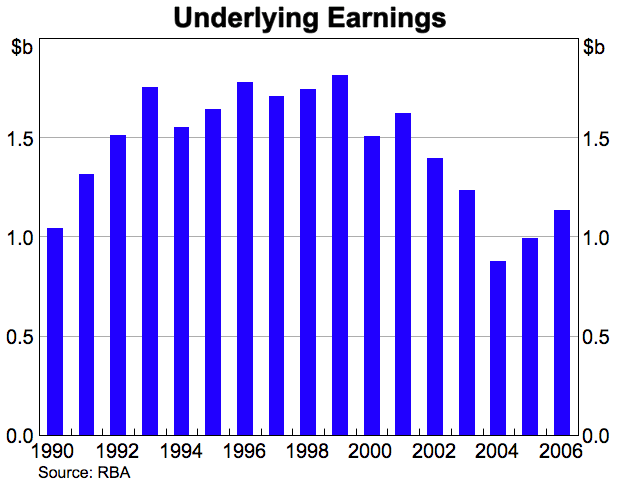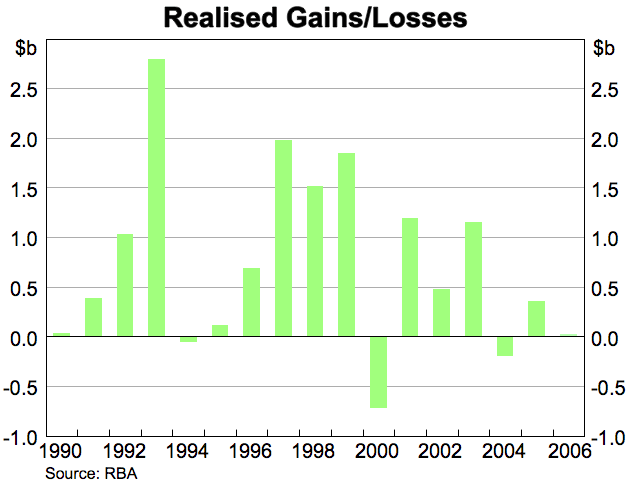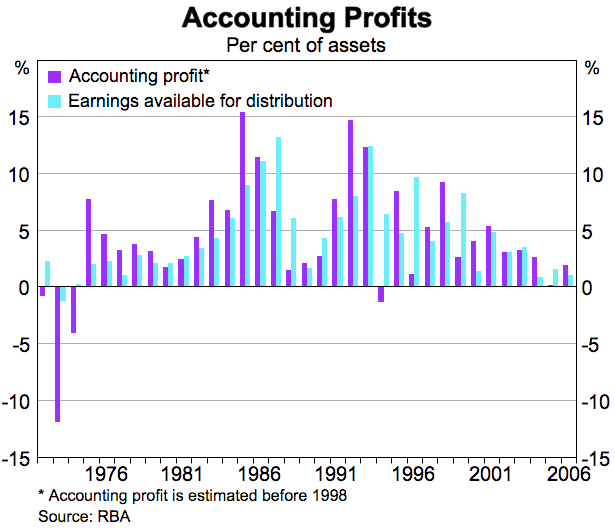Reserve Bank of Australia Annual Report – 2006 Earnings and Distribution
The Reserve Bank earns income from the portfolio of financial assets that it holds to undertake operations to implement monetary policy. These assets are invested primarily in securities denominated both in Australian dollars and in the foreign currencies in which Australia's international reserves are invested. The management of these assets is discussed in the chapter on ‘Operations in Financial Markets’, while a discussion of associated risks appears in the chapter on ‘Risk Management’.
The Reserve Bank's assets provide two general sources of income – net interest income, and valuation gains or losses. Net interest income is the difference between the interest received on the portfolio of domestic and foreign assets and the interest paid on liabilities such as deposits. The Reserve Bank also earns relatively small amounts of other income from fees on the financial services it provides and rental income. The Reserve Bank's underlying earnings, which are fairly predictable, comprise net interest income plus fees and rent minus its operating costs. The underlying earnings are typically quite large because, while almost all of the Reserve Bank's assets earn interest, interest is not paid on a significant proportion of its liabilities, in particular currency in circulation and capital and reserves. Valuation gains occur when the prices of the assets it holds rise either because market interest rates fall or, for foreign assets, when the exchange rate of the Australian dollar depreciates; valuation losses occur when interest rates rise or the Australian dollar appreciates. Valuation gains and losses are realised only when assets are sold.
As the Reserve Bank prepares its financial reports on the basis of Australian equivalents to International Financial Reporting Standards (AIFRS), the Reserve Bank's accounting profits comprise earnings from all sources, including unrealised valuation gains and losses. The Reserve Bank Act 1959, however, specifies the components of profits that are available to be distributed as a dividend to the Reserve Bank's owner, the Australian Government.
Distributable Earnings
Section 30 of the Reserve Bank Act 1959 provides that earnings available for distribution comprise the Reserve Bank's underlying earnings plus any realised gains or losses. Unrealised valuation gains are not available to be distributed but are transferred to (or, in the case of losses, from) the Unrealised Profits Reserve. Balances in this reserve are held against the possibility of future valuation losses or are realised when assets are sold.

Looking at the results for 2005/06, underlying earnings totalled $1,156 million, compared with $997 million in the previous year. The increase in underlying earnings in 2005/06 reflects rises in short‑term interest rates in Australia, the United States and Europe. In the past couple of years, underlying earnings have increased after a run of years during which they had fallen as short‑term interest rates globally had moved to historically low levels.
Realised gains, the more volatile component of distributable earnings, amounted to $21 million in 2005/06, compared with $366 million in 2004/05. Gains of $362 million were realised from the sale of foreign exchange. However, losses of $332 million were realised on holdings of foreign securities and there were losses of $30 million on domestic assets. The loss on foreign investments reflected turnover in these assets, in the course of managing international reserves, at higher market yields (lower prices) than those at which they were purchased. Gains of $21 million were realised from the sale of gold coin that the Reserve Bank decided it no longer needed to hold.

| Underlying Earnings |
Realised Gains and Losses |
Earnings Available for Distribution |
||
|---|---|---|---|---|
| 1986/87 | 1,412 | 2,035 | 3,447 | |
| 1987/88 | 1,062 | 464 | 1,526 | |
| 1988/89 | 891 | −474* | 417 | |
| 1989/90 | 1,049 | 46* | 1,095 | |
| 1990/91 | 1,322 | 391 | 1,713 | |
| 1991/92 | 1,516 | 1,038 | 2,554 | |
| 1992/93 | 1,760 | 2,803 | 4,563 | |
| 1993/94 | 1,556 | −48* | 1,508 | |
| 1994/95 | 1,649 | 123 | 1,772 | |
| 1995/96 | 1,784 | 702* | 2,486 | |
| 1996/97 | 1,715 | 1,990 | 3,705 | |
| 1997/98 | 1,750 | 1,524 | 3,274 | |
| 1998/99 | 1,816 | 1,860* | 3,676 | |
| 1999/00 | 1,511 | −708 | 803 | |
| 2000/01 | 1,629 | 1,205 | 2,834 | |
| 2001/02 | 1,400 | 489 | 1,889 | |
| 2002/03 | 1,238 | 1,159 | 2,397 | |
| 2003/04 | 882 | −188 | 694 | |
| 2004/05 | 997 | 366 | 1,363 | |
| 2005/06 | 1,156 | 21 | 1,177 | |
| * Includes unrealised losses in excess of previous years’ unrealised gains held in reserves. | ||||
Earnings available for distribution – the sum of underlying earnings and realised gains – amounted to $1,177 million in 2005/06, compared with $1,363 million in the previous year.
Reserves and Dividend
The Reserve Bank Reserve Fund (RBRF) is the Reserve Bank's permanent general reserve. It is available to cover potential losses from a range of risks, especially the substantial market risks faced by the Reserve Bank. The RBRF is also available to cover losses from fraud, operational risks and other risks of the sort faced by most financial institutions. The RBRF has been funded over time by transfers from earnings available for distribution and is akin to capital.
Consistent with the Reserve Bank Act 1959, after consultation with the Reserve Bank Board, the Treasurer determines the amount, if any, to be credited to the RBRF from earnings available for distribution. The balance of distributable earnings after any such transfers is payable as a dividend to the Australian Government. At 30 June 2006, the balance of the RBRF stood at $6,286 million. This was an increase of $1 million compared with the published accounts at the previous balance date, reflecting accounting adjustments associated with minor asset revaluations under AIFRS. As the Board regards the current balance in the RBRF as satisfactory, it did not approach the Treasurer for a transfer from profits in 2005/06. Consequently, all of the earnings available for distribution in 2005/06 will be paid as a dividend to the Australian Government.
Dividends are usually paid to the Government early in the financial year following that in which profits are earned. In some recent years, the Treasurer has decided to defer part of the dividend payable, spreading the payment over two years. Last year, the Treasurer deferred until 2006/07 the sum of $300 million from the dividend due to be paid in 2005/06. None of the dividend payable in 2006/07 from profits in 2005/06 is to be deferred. Accordingly, a total amount of $1,477 million will be paid to the Australian Government in August 2006 – as summarised in the table below. The total sum payable in August 2006 is $94 million more than was paid in 2005.
| Sum deferred from Earnings in 2004/05 (to be paid in 2006/07) | 300 |
|---|---|
| Plus | |
| Total Distributable Earnings from 2005/06 (payable in 2006/07) | 1,177 |
| Total Payment in 2006/07 | 1,477 |
In addition to the RBRF, the Reserve Bank maintains a number of other financial reserves. As noted, under the Reserve Bank Act 1959 unrealised gains are not available to be distributed but are transferred to the Unrealised Profits Reserve, to absorb future valuation losses or to be realised when relevant assets are sold. On 30 June 2006, the balance in the Unrealised Profits Reserve was $2,528 million. This approach, embedded in legislation, reflects sound practice since it recognises the principle that unrealised gains should not be distributed, as this would erode the capacity to cope with subsequent unrealised losses. Experience shows that such losses do occur and are virtually inevitable because, as the Reserve Bank's operations are driven by policy considerations, it has no scope to control the market risks faced on domestic assets and only limited scope to do so in the case of foreign assets.

One effect of these arrangements is that earnings available for distribution, although they still fluctuate considerably, tend to follow a less volatile path than they would if earnings from all sources were required to be distributed – dividends tend to be lower than otherwise in years in which the Reserve Bank records unrealised gains and higher in years in which it records unrealised losses. The most important consideration, however, is that the arrangements mean that the Reserve Bank will usually have sufficient resources to absorb significant unrealised losses in years in which interest rates or the exchange rate move unfavourably. As it happens, transfers from the reserve (associated with unrealised losses) have occurred over a long run of years about as often as transfers to the reserve (associated with unrealised gains), although the current credit balance means that the value of total transfers to the Unrealised Profits Reserve has exceeded transfers from it.
| Earnings Available for Distribution |
Transfers to Reserves |
Payments to the Australian Government | |||||
|---|---|---|---|---|---|---|---|
| Balance Available from Current Year's Profit |
Interim Payment from Current Year's Profit |
Payment from Previous Year's Profit |
Payment Delayed from Previous Years |
Total Payment |
|||
| 1990/91 | 1,713 | 210 | 1,503 | 400 | 275 | – | 675 |
| 1991/92 | 2,554 | 200 | 2,354 | 400 | 1,103 | – | 1,503 |
| 1992/93 | 4,563 | 750 | 3,813 | 600 | 1,954 | – | 2,554 |
| 1993/94 | 1,508 | – | 1,508 | – | 3,213 | – | 3,213 |
| 1994/95 | 1,772 | – | 1,772 | 200 | 1,508 | – | 1,708 |
| 1995/96 | 2,486 | 150 | 2,336 | 200 | 1,572 | – | 1,772 |
| 1996/97 | 3,705 | 2,005 | 1,700 | – | 2,136 | – | 2,136 |
| 1997/98 | 3,274 | 548 | 2,726 | – | 1,700 | – | 1,700 |
| 1998/99 | 3,676 | – | 3,676 | – | 2,726 | – | 2,726 |
| 1999/00 | 803 | – | 803 | – | 3,000 | – | 3,000 |
| 2000/01 | 2,834 | – | 2,834 | – | 803 | 676 | 1,479 |
| 2001/02 | 1,889 | – | 1,889 | – | 2,834 | – | 2,834 |
| 2002/03 | 2,397 | 133 | 2,264 | – | 1,889 | – | 1,889 |
| 2003/04 | 694 | – | 694 | – | 1,300 | – | 1,300 |
| 2004/05 | 1,363 | – | 1,363 | – | 374 | 964 | 1,338 |
| 2005/06 | 1,177 | – | 1,177 | – | 1,063 | 320 | 1,383 |
| 2006/07 | – | – | – | – | 1,177 | 300 | 1,477 |
The Reserve Bank also maintains asset revaluation reserves, the balances of which reflect the amount by which the market value of its holdings of gold and property exceed the prices at which they were purchased. At 30 June 2006, balances in these reserves totalled $2,354 million, $672 million higher than a year earlier, mainly reflecting the increase in the price of gold.
Accounting Profits
As noted above, since the basis of the Reserve Bank's financial disclosures is AIFRS, it discloses its accounting profits as profits from all sources, including unrealised gains and losses, in line with the Finance Minister's Orders, issued under the Commonwealth Authorities and Companies Act 1997. As the Reserve Bank recorded unrealised gains of $933 million in 2005/06 in addition to distributable earnings of $1,177 million, its accounting profits amounted to $2,093 million after allowing for a transfer from an asset revaluation reserve associated with the sale of gold coin.
Financial Disclosure
The Reserve Bank's financial statements for 2005/06 were prepared for the first time in accordance with AIFRS. The Notes to the Accounts report the effects of adopting AIFRS on the financial statements, which are presented in the following pages.